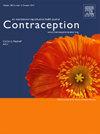口服与阴道激素避孕的差异骨钙潴留:一项使用钙-41放射性示踪剂的随机试验。
IF 2.8
2区 医学
Q1 OBSTETRICS & GYNECOLOGY
引用次数: 0
摘要
目的:本研究旨在评估口服激素避孕(联合口服避孕药,COC)或阴道(避孕阴道环)对年轻女性骨钙潴留的影响是否存在差异。研究设计:未使用激素避孕的育龄女性(18-35岁)在10ml无菌生理盐水(0.9%)中加入50 nCi 41Ca作为CaCl2。在≥100天的平衡期和2个月经周期基线后,参与者按随机顺序使用COC和环各2个周期(49天),分开并随后有2个月经周期的洗脱期。在平衡期间每月收集24小时尿液样本,在基线、干预和冲洗期间每~10天收集一次尿液样本,通过加速质谱分析尿液中41Ca:Ca比值来评估骨钙潴留。通过使用线性模型和广义线性混合模型,将每次避孕干预期间测量的41Ca:Ca与“对照”(基线和洗脱)阶段测量的41Ca:Ca进行比较,确定每种避孕措施的效果。结果:对8名育龄女性进行了研究。与对照期(基线期和冲洗期)相比,COC导致更大的骨钙潴留(11.3%,95% CI: 6.7%, 15.6%)。该环未改变骨钙潴留(4.2%,95% CI: -6.6%, 13.9%)。COC对钙潴留的影响大于环(p=0.03)。结论:尽管许多因素有助于骨骼健康,短期COC可改善骨钙潴留,提示COC对女性骨骼的潜在益处。相反,这个环并没有改变钙潴留,可能对骨骼既没有好处也没有坏处。临床试验注册号:ClinicalTrials.gov ID: NCT02367846注册日期:2015年1月27日。本文章由计算机程序翻译,如有差异,请以英文原文为准。
Differential bone calcium retention with the use of oral versus vaginal hormonal contraception: A randomized trial using calcium-41 radiotracer
Objectives
This study aimed to assess if hormonal contraception administered orally (combined oral contraceptive pill, COC) or vaginally (contraceptive vaginal ring) differentially affected bone calcium retention in young females.
Study design
Reproductive aged females (18–35 years) not using hormonal contraception were dosed with 50 nCi 41Ca as CaCl2 in 10 mL of sterile saline (0.9%). Following an equilibration phase of ≥100 days and a baseline of two menstrual cycles, participants used COC and the ring for two cycles (49 days) each, in a randomized order, separated and followed by washouts of two menstrual cycles. Twenty-four-hour urine samples were collected monthly during equilibration and every around 10 days during baseline, interventions, and washouts to assess bone calcium retention through accelerator mass spectrometry analysis of the 41Ca:Ca ratio in urine. The effect of each contraception was determined by comparing 41Ca:Ca measured during each contraception intervention to 41Ca:Ca measured during the “control” (baseline and washout) phases using linear models and generalized linear mixed models.
Results
Eight reproductive aged females were studied. Compared with control phases (baseline and washouts), COC resulted in greater bone calcium retention (11.3%, 95% CI: 6.7%, 15.6%). The ring did not alter bone calcium retention (4.2%, 95% CI: −6.6%, 13.9%). COC produced a greater change in calcium retention than the ring (p = 0.03).
Conclusion
Although many factors contribute to bone health, short-term COC improved bone calcium retention, suggesting a potential benefit of COC to bone in females. Conversely, the ring did not alter calcium retention, and may be neither beneficial nor deleterious for bone.
Implications
In this study, the effects of oral (pill) vs. vaginal (ring) hormonal contraception on bone calcium retention were assessed in young females. The pill improved bone calcium retention, suggesting a potential beneficial effect on bone health; the ring did not change bone calcium retention compared with control (no contraception).
求助全文
通过发布文献求助,成功后即可免费获取论文全文。
去求助
来源期刊

Contraception
医学-妇产科学
CiteScore
4.70
自引率
17.20%
发文量
211
审稿时长
69 days
期刊介绍:
Contraception has an open access mirror journal Contraception: X, sharing the same aims and scope, editorial team, submission system and rigorous peer review.
The journal Contraception wishes to advance reproductive health through the rapid publication of the best and most interesting new scholarship regarding contraception and related fields such as abortion. The journal welcomes manuscripts from investigators working in the laboratory, clinical and social sciences, as well as public health and health professions education.
 求助内容:
求助内容: 应助结果提醒方式:
应助结果提醒方式:


